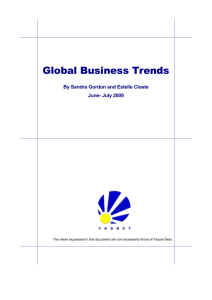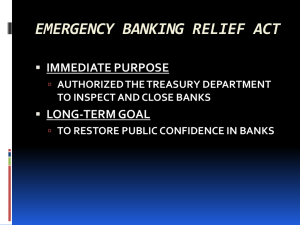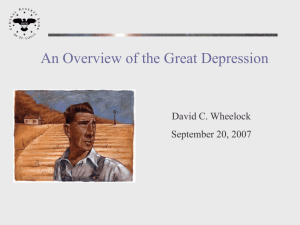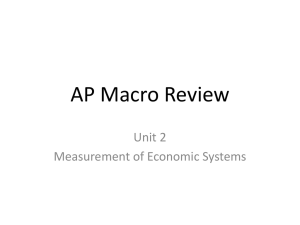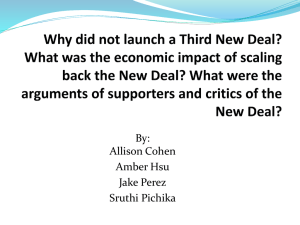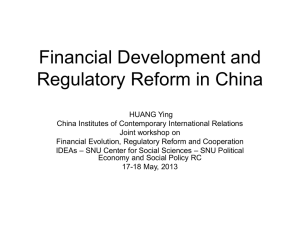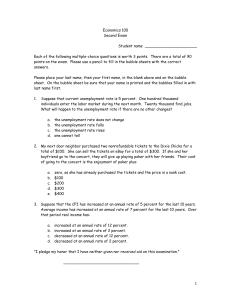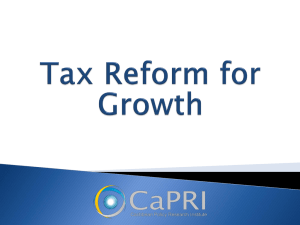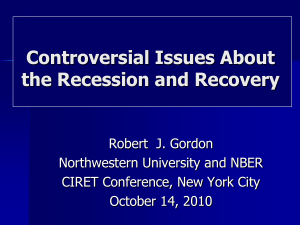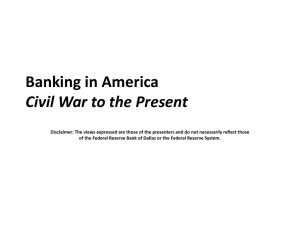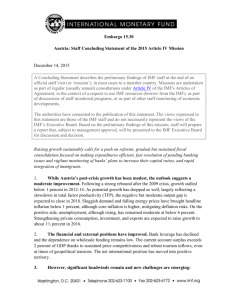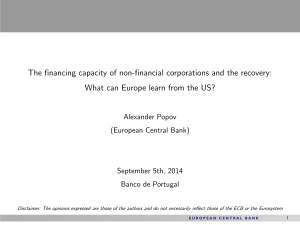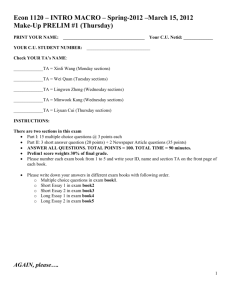Lesson 4- Dealing with the Great Depression
advertisement
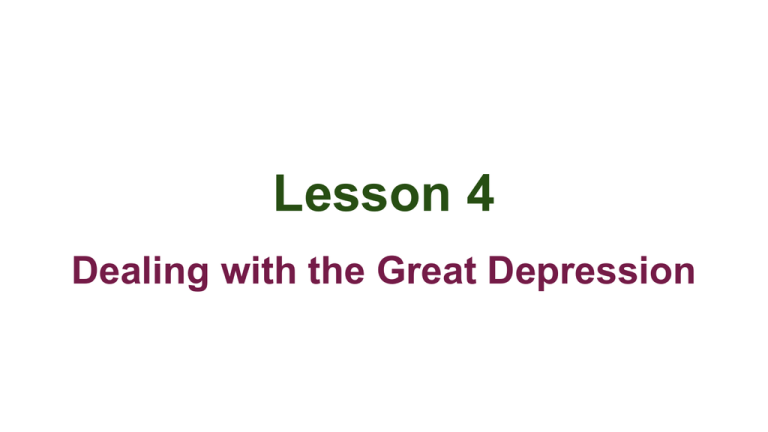
Lesson 4 Dealing with the Great Depression 1930 and Beyond ● ● ● ● By 1930, business activity had slowed. Sales had fallen Unemployment was rising Many business that had borrowed money from banks were unable to repay their loans ● Prices were falling, but so were incomes ● As income declined, demand for goods and services decreased. 1930 and Beyond ● Between 1929 and 1933, bank suspension, unemployment and financial distress presented a challenge for the United States. ● Bank suspension include all banks closed to the public because of financial difficulties. Visual 4.1: U.S. Statistical Data Question: What happened to the number of bank suspension between 1929 and 1933? Answer: Each year except 1931-1932 shows an increase in the number of bank suspension. Visual 4.1 Question: Why is the number of bank suspension important? Answer: When the banks closed, people lost their money and their confidence in banks. People withdrew their money, causing more banks to close. Visual 4.1 Question: What happened to the unemployment rate during these years? Answer: The unemployment rate increased each year Question: What happened to per capita personal income during these years? Answer: decreased each year Visual 4.1 Question : What happened to real GDP each year? Answer: Each year, real GDP decrease Question? What conclusion can be drawn about the standard of living for families during this time? Answer: Unemployment, income falling Comprehension Check Point 1. 2. 3. 4. 5. 6. When banks failed, depositors lost their _______ People lost confidence in the __________ People with money rush to _____ their money from the bank. The money supply ___________ People that were unemployed had no _______ and were unable to purchase ______ and _________ which resulted in __________ GDP. Handout: 4.2 U.S. Statistical Data 1. Work with your partner to complete the 10 questions. 2. While answering the question, also keep the following questions in mind… a. If you were an American citizen during that period of time, would be happy with the direction in which the economy was going? b. Would you be ready for a change in leadership? c. Would you vote for a new president? you Important Facts ● Herbert Hoover was the president in 1932 ● Franklin Delano Roosevelt ran against Herbert Hoover stating, “I pledge you, I pledge myself, to a new deal for the American people.” ● At the time, FDR did not know what the “new deal” would include The New Deal Programs ● The New Deal programs also referred to as “alphabet soup.” ● There were two parts to the New Deal 1. 1933-1934 2. 1935-1941 ● The goal of the New Deal was to restore confidence in the economy. The New Deal Programs ● The New Deal focused on three areas-relief, recovery, and reform: ● relief programs to help immediately ● recovery programs to help rebuild ● reform programs to prevent the disaster from reoccuring The New Deal Programs Activity 1. Your group is provided with a bag, inside the bag your group will find a Label Mat and New Deal Cards 2. Read each card carefully 3. Sort each card on the initial intent program-relief, recovery, or reform 4. If a card describes a program that fits into more than one category, place the card in the fourth group “combination.” 5. After your group is finish sorting the cards, discuss the following questions: a. What features were common to the cards you put together in a category? b. Why might some programs fit in more than one category? Federal Government Spending ● The federal government had to borrow large amounts of money to pay for New Deal programs. ● When federal government expenditures exceed the revenue collected by the government in a year, the government has a budget deficit. ● The government borrows money to cover the amount of expense not covered by revenue, which created government debt. ● National debt is the accumulation of deficits Federal Government Spending ● As a result of New Deal spending, the national debt rose from approximately $21 billion in 1933 to almost $43 billion by 1940. ● The deficit during FDR’s first fiscal year was the highest in U.S. history up to that time, outside the war. Effect of the New Deal Activity ● Each of you were given a card. ● When I call your number, I would like for to stand under the following---relief, reform, recovery/combination. ● You will talk amongst yourselves and decide whether your program caused an increased, decreased, or had mixed effects on each variable listed on the chart--unemployment rate, government spending, GDP, confidence level and role of government. ● Mixed effects would mean that some of their programs caused an increase in variable while other programs cause a decreased in the variable. Comprehension Check: Lesson Quiz 1. 2. 3. 4. 5. 6. What are the elements shown on the visual? Why was the banking holiday and banking legislation important? To what budget changes does the cartoonist refers? What was the impact of the government spending on the budget? What was the purpose of the New Deal programs? What was the effect of the New Deal on the role of government in the economy? 7. What was the effect of the New Deal on federal government spending? 8. In general, what was the effect of the New Deal programs on citizens’ confidence in the banking system and the economy?
